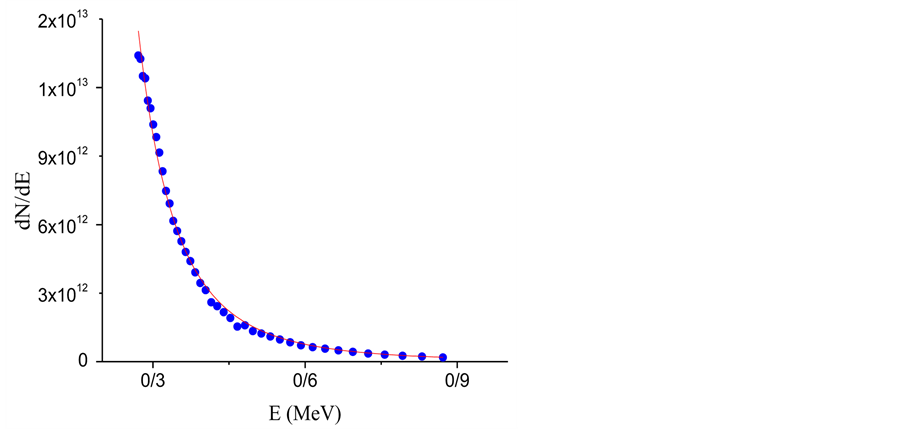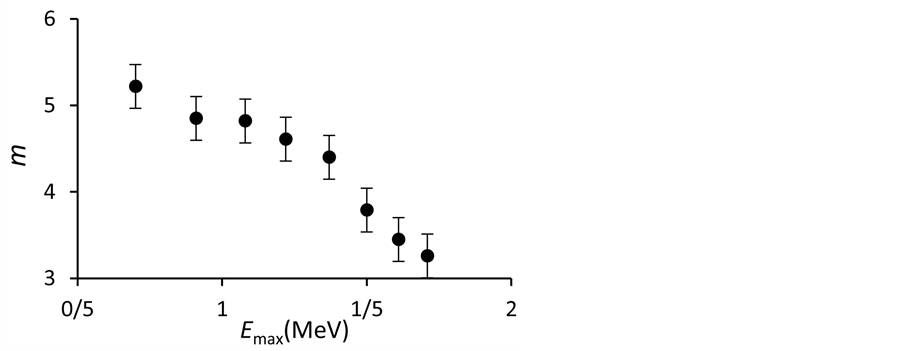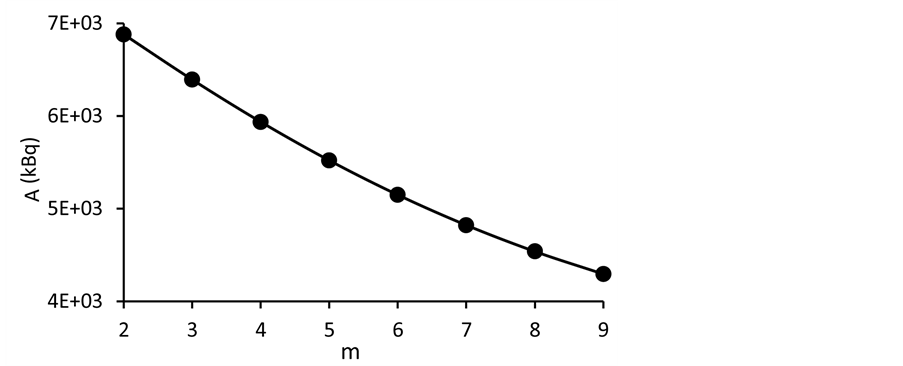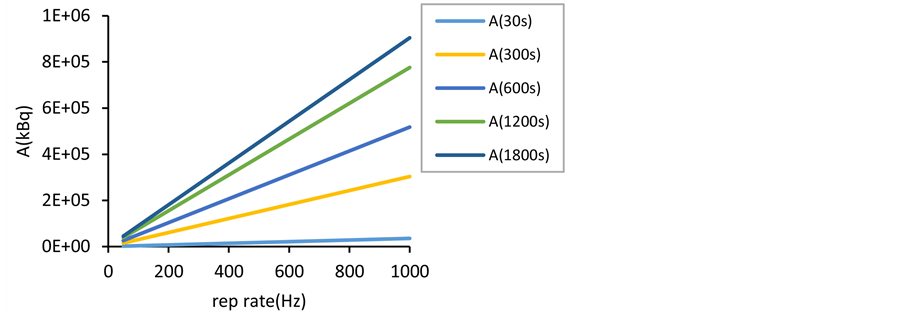Journal of Modern Physics
Vol.07 No.12(2016), Article ID:70132,7 pages
10.4236/jmp.2016.712138
The Investigation Capability of Plasma Focus Device for 13N Radioisotope Production by Means of Deuteron Experimental Spectrum
Maryam Saed1, Mahmud Vahdat Roshan2, Ayoub Banoushi3, Morteza Habibi4
1Islamic Azad University Tehran Central Branch, Tehran, Iran
2School of Particles and Accelerators, Institute for Research in Fundamental Sciences (IPM), Tehran, Iran
3Research Institute of Nuclear Science and Technology of Iran, Tehran, Iran
4AmirKabir University of Technology, Tehran, Iran

Copyright © 2016 by authors and Scientific Research Publishing Inc.
This work is licensed under the Creative Commons Attribution International License (CC BY).
http://creativecommons.org/licenses/by/4.0/



Received 13 June 2016; accepted 23 August 2016; published 26 August 2016
ABSTRACT
Optimal condition for 13N radioisotope production through 12C (d,n) 13N within plasma focus device is investigated. As the deuteron spectrum follows the empirical power law of the form E−m, it is shown that the activity decreases by increasing the value of m. Unlike the fact that the repetition rate increases the activity, it is possible to achieve higher activities by increasing the bombardment time at a fixed repetition rate.
Keywords:
Positron Emission Tomography (PET), Plasma Focus, Deuteron Spectrum, Activation, Repetition Rate

1. Introduction
Short-lived radioisotopes (SLR) such as 11C, 13N, 15O, 18F usually have medical applications, particularly in positron emission tomography (PET). These radioisotopes are obtained through bombarding appropriate targets by ion beams produced in accelerators. Due to the short half-life of such radioisotopes, which is one of the advantages of this method over others, they must be produced in a place where they are expected to be used. To this end, accelerators have to be used in hospitals. PET radioisotopes production by means of cyclotron is an expensive method, therefore it is suitable to consider pulsed plasma devices to produce PET radioisotope.
Plasma focus devices are one of the appropriate systems in producing short lived radioisotopes because they are low cost and easy to use and maintain.
As a switch is closed in a plasma focus device, a voltage of several tens kV is quickly applied to the electrodes. Due to gas electrical breakdown, free electrons move toward the insulation surface, afterward a current layer is formed. Because of the effect of Lorentz force (J × B) on the current layer, the layer is ac- celerated towards the end of electrodes at a high speed. By the radial Lorentz force, a part of the current layer symmetrically moves towards the center of anode and a very short-lived, dense, hot plasma column is formed which is the source of ion, electron, X-ray and neutron production.
The voltage of capacitor bank for a plasma focus device is usually 10 - 30 kV, but the results of a lot of experiments [1] have shown that deuteron beams emitted from the pinch have a wide range of energy (up to several MeV). Ion acceleration with such high energy is one of the most unexpected aspects of the plasma focus device. Several models have been suggested for acceleration of ions [1] such as instabilities, anomalous resistivity, plasma wave, and shock wave. However, the ion acceleration mechanism in the plasma focus pinch is not understood well. The most important factor in ions acceleration is the m = 0 instability (sausage instability). This instability is often attributed to the acceleration of ions at high energy. The growth of such instabilities is due to radially symmetric disturbances in certain points. At these points, the cross sectional area is reduced, and then azimuthal magnetic field strength at the surface of the plasma will be extended. The magnetic pressure will be increased. As a result, the plasma column at these points compared to other pointsconstricts at a faster rate. Rapid changes of magnetic field at each constriction induce a large longitudinal electric field that accelerates ions within the plasma column at higher energies [2] .
A good candidate for studying radioisotope production within the plasma focus is the nuclear reaction of 12C (d,n) 13N. The advantages of this reaction are high cross section, low threshold energy, short half-life, and the availability of target materials [3] .
Through bombarding the graphite target by high energy deuterons, Nitrogen-13 is produced via the following reaction:

The threshold energy of this reaction is 328 keV. Nitrogen13 is a SLR and it decays with the half-life of 9.96 minutes and produces a positron (b+). The positrons are stopped in the graphite (positron speed is slowed down) and is annihilated with an electron. Two oppositely directed 511 keV gamma-rays are produced by the annihi- lation of every electron- positron pair.
Radioisotope production within plasma focus has been taken into consideration for a long time. Brzosko group [4] in the U.S., Angeli [5] in Italy, Roshan [6] in Singapore can be named. The amount of activity produced in Singapore group has remarkably increased. Roshan et al. [6] have carried out their experiments on a plasma focus device NX2. They placed the target graphite  to a distance of 100 mm in front of deuteron beam within NX2 device so that the solid angle between deuterons and target graphite was
to a distance of 100 mm in front of deuteron beam within NX2 device so that the solid angle between deuterons and target graphite was .
.
The activity reported by Roshan et al. within NX2 device with repetition rate of 1 Hz after 30 seconds of graphite bombardment was equal to 5.2 kBq [6] . This amount in this small device (1.7 kJ) is better than the reported activity of bigger devices. However, it is not very important for medical applications.
In this study, first the activity of a set of experimental spectra of deuteron produced by NX2 plasma focus device which has been measured by magnetic spectrometer [7] is calculated and then the optimizing conditions of 13N production is investigated.
2. 13N Activity Calculation Phases
Thick target yield shows the reaction probability or reaction rate [6] :
 (1)
(1)
where N is the number of nitrogen 13 nuclei per cubic centimeter;  is the cross section of reaction 12C
is the cross section of reaction 12C
(d,n) 13N;  is stopping power of deuterons on graphite target, and
is stopping power of deuterons on graphite target, and  is the incident energy of deuterons.
is the incident energy of deuterons.
The data of cross section of the reaction 12C (d,n) 13N is obtained from EXFOR data base [8] and SRIM code [9] is used to calculate reaction stopping power (Figure 1). In Figure 1, the blue points are experimental data
Figure 1. Deuteron stopping power in the graphite target.
(by means SRIM code) and the red curve is the fitted diagram on experimental data.
The total number of activated nitrogen 13 nuclei in the target estimated from [6] :
 (2)
(2)
According to the conducted experiments, deuteron spectrum follows the empirical power law of the form [6] [10] [11] :
 (3)
(3)
In this paper, we fit the generated deuteron spectra in plasma focus device NX2 (1.7 kJ energy) by Equation (3). One of deuteron spectra has been given as an instance in Figure 2. We have fitted this deuteron spectrum by the exponential function in Equation (3) and it fits with Equation (4) spectrum. In Figure 2, the blue points are experimental data and the red curve is the fitted diagram according to Equation (4) on experimental data.
 (4)
(4)
The number of 13N nuclei can be calculated by replacing Equation (4) in Formula 2. Then, the activity is calculated.
13N activity, resulting from deuteron collision (Figure 2) to graphite target has been calculated, A = 0.616 kBq.
3. The Investigation Capability of Plasma Focus Device for 13N Radioisotope Production
13N radioisotope is achieved based on 12C(d,n) 13N process. The amount of 13N activity is dependent on the whole deuteron spectrum descended upon 12C solid target. As illustrated in Figure 2, deuteron energy spectrum
follows the power law , with the investigations conducted on three sets of deuteron spectra
, with the investigations conducted on three sets of deuteron spectra
(within pressures of 4, 6, 8 mbar [7] ), we realized that the number of incident deuterons and the energy of these
deuterons will be reduced with an increase of the amount of m in the exponential function .
.
Figure 3 depicts m changes based on maximum energy of deuterons spectra. As it is clear in the figure, the energy of these deuterons will be reduced with an increase of the amount of m and with the calculation of 13N activity (as a consequence of the collision of these deuteron spectra with 12C target) it was found that in the spectra with higher m, we would have less activity.
Moreover, the investigation of experimental spectra [7] shows that as the number of incident deuterons increase, the value of m decreases and the activity increases.
For a better description of deuterons dependence on 13N activity, we have calculated the number of 13N nuclei
Figure 2. Spectrum of deuteron produced in NX2 plasma focus device [7] .
Figure 3. Maximum energy of experimental spectra of deuteron and its corresponding m.
for three series of deuteron spectra [11] .
The relationship between m and A is obtained from the following formula [12] .

where 


In order to calculate 
Device energy [13] [14] and repetition rate are factors affecting the rate of activity. As the device energy and the repetition rate increases, the number of incident deuterons will increase as well. Consequently, the rate of
Figure 4. Relationship between m and A.
activity will increase remarkably.
In this research, for optimizing Nitrogen 13 radioisotope, the repetition rate is selected as an influential factor in increasing activity.
The activity after k successive shot [15] :

The effect of repetition rate on the amount of activity at frequencies of 1 Hz, 5 Hz, 10 Hz and 16 Hz during the bombardment time of 30 s (the time considered in the lab [6] ), 300 s (1/2 of radioisotope half-life), 600 s (1 half-life), 1200 s (2 half-life) 1800 s (3 half-life) is investigated and its diagram is drawn.
As shown in Figure 5, as the repetition rate increases, the activity will also increase in such a way that at repetition rate of 1 Hz after one half-life (600 s), target bombardment is 0.2 MBq, while at the same bom- bardment time (one half-life) the activity at repetition rate of 16 Hz is 4 MBq. As a result, repetition rate is a very effective factor in increasing the activity.
The required activity for PET is more than 1 GBq. The calculated activity for one of the experimental spectra of deuteron at repetition rate of 16 Hz and bombardment time of 600 s (Acal = 8 MBq) is less than the required activity for imaging. In order to investigate the ability of plasma focus device for producing the required activity for imaging, by increasing the repetition rate, the activity is calculated at higher frequencies. Therefore, activity at frequencies of 50 Hz, 100 Hz, 500 Hz, and 1 kHz was examined. As shown in Figure 5, activity at repetition rate of 1 kHz after 1800 s is 0.9 GBq. Due to technical restrictions within the available plasma focus devices, achieving such a high repetition rate is difficult. For this reason, instead of increasing the repetition rate, we can increase the bombardment time at a fixed repetition rate. Figure 6 shows the activity at a fixed repetition rate with different bombardment time.
The activity could be increased by increasing the device energy, too [13] . It was shown that there is a linear relationship between device energy and the activity. In order to reach to the required activity for PET imaging, the plasma focus energy should be in the order of kilo joules.
4. Conclusions
A series of experimental deuteron spectra was used to show that the activity is highly dependent on the power of m in the empirical power law distribution of the deuterons. By decreasing the value of m, the energy and the number of incident deuterons will increase which will lead to the increment of the activity. Since the repetition rate of the device is a straight forward factor for increasing the number of incident deuterons, the activity is optimized by repetition rate.
In order to produce the practical activity for PET imaging, the repetition rate should be around 1 kHz which is
Figure 5. Activity in terms of repetition rate.
Figure 6. Activity in terms of bombardment time.
technically difficult to achieve. Therefore, the bombardment time is increased at a fixed repetition rate.
Cite this paper
Maryam Saed,Mahmud Vahdat Roshan,Ayoub Banoushi,Morteza Habibi, (2016) The Investigation Capability of Plasma Focus Device for 13N Radioisotope Production by Means of Deuteron Experimental Spectrum. Journal of Modern Physics,07,1512-1518. doi: 10.4236/jmp.2016.712138
References
- 1. Shirani, B., Abbasi, F. and Fusion, J. (2012) Prospects for 13N Production in a Small Plasma Focus Device. Journal of Fusion Energy, 32, 235-241.
http://dx.doi.org/10.1007/s10894-012-9558-9 - 2. Lee, S. and Saw, S.H. (2012) Physics of Plasmas, 19, Article ID: 112703.
http://dx.doi.org/10.1063/1.4766744 - 3. Roshan, M.V., Razaghi, S., Asghari, F., Rawat, R.S., Springham, S.V., Lee, P., Lee, S. and Tan, T.L. (2014) Physics Letters A, 3, 78.
- 4. Bienkowska, B., Jednorog, S., Ivanova-Stanik, I.M., Scholz, M. and Szydlowski, A. (2004) Acta Physica Slovaca, 54, 401-407.
- 5. Sadowski, M., Ese, M., Moroso, R. and Pouzo, J. (2000) Nukleonika, 45, 179-184.
- 6. Sadowski, M., Szydlowski, A., Scholz, M., Kelly, H., Marquez, A. and Lepone, A. (1999) Radiation Measurements, 31, 185-190.
http://dx.doi.org/10.1016/S1350-4487(99)00083-9 - 7. Ziegler, J.F. (2013) SRIM—The Stopping and Range of Ions in Matter.
http://www.srim.org/ - 8. Zerkin, V. (2014) Experimental Nuclear Reaction Data (EXFOR).
https://www-nds.iaea.org/exfor/exfor.htm - 9. Roshan, M.V., Springham, S.V., Talebitaher, A., Rawat, R.S. and Lee, P. (2010) Plasma Physics and Controlled Fusion, 52, Article ID: 085007.
http://dx.doi.org/10.1088/0741-3335/52/8/085007 - 10. Roshan, M.V., Springham, S.V., Rawat, R.S. and Lee, P. (2010) IEEE Transactions on Plasma Sciences, 38, 3393-3397.
http://dx.doi.org/10.1109/TPS.2010.2083699 - 11. Angeli, E., Tartaria, A., Frignanic, M., Mostaccib, D., Rocchic, F. and Sumini, M. (2005) Nuclear Technology & Radiation Protection, 1, 33-37.
- 12. Brzosko, J.S., Melzacki, K., Powell, C. and Gai, M. (2001) Application of Accelerators in Research and Industry. Sixteenth International Conference of the American Institute of Physics, 277-280.
- 13. Gulickson, R.L., Pickles, W.L., Price, D.F., Salhin, H.L. and Wainwright, T.E. (1978) Ion Beam Production in the Plasma Focus. The Second International Conference on Energy Storage, Compression, and Switching, Venice, 5-8 December 1978.
- 14. Kruskal, M. and Schwarzschild, M. (1954) Proceedings of the Royal Society A, 223, 348.
http://dx.doi.org/10.1098/rspa.1954.0120 - 15. Bernstein, M.J. and Comisar, G.G. (1972) Physics of Fluids, 15, 700.
http://dx.doi.org/10.1063/1.1693966







